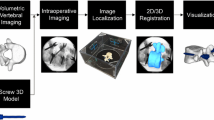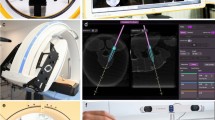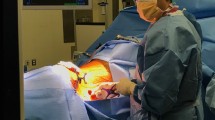Abstract
Purpose
Description of a novel method for evaluation of pedicle screws in 3 dimensions utilizing O-arm® and StealthStation® navigation; identifying sources of error, and pearls for more precise screw placement.
Methods
O-arm and StealthStation navigation were utilized to place pedicle screws. Initial and final O-arm scans were performed, and the projected pedicle probe track, projected pedicle screw track, and final screw position were saved for evaluation. They were compared to evaluate the precision of the system as well as overall accuracy of final screw placement.
Results
Thoracolumbar deformity patients were analyzed, with 153 of 158 screws in adequate position. Only 5 screws were malpositioned, requiring replacement or removal. All 5 were breached laterally and no neurologic or other complications were noted in any of these patients. This resulted in 97 % accuracy using the navigation system, and no neurological injuries or deficits. The average distance of the screw tip and angle of separation for the predicted path versus the final pedicle screw position were analyzed for precision. The mean screw tip distance from the projected tip was 6.43 mm, with a standard deviation of 3.49 mm when utilizing a navigated probe alone and 5.92 mm with a standard deviation of 3.50 mm using a navigated probe and navigated screwdriver (p = 0.23). Mean angle differences were 4.02° and 3.09° respectively (p < 0.01), with standard deviations of 2.63° and 2.12°.
Conclusions
This new technique evaluating precision of screw placement in 3 dimensions improves the ability to define screw placement. Pedicle screw position at final imaging showed the use of StealthStation navigation to be accurate and safe. As this is a preliminary evaluation, we have identified several factors affecting the precision of pedicle screw final position relative to that predicted with navigation.








Similar content being viewed by others
References
Boucher HH (1959) A method of spinal fusion. J Bone Joint Surg Br 41-B:248–259
King D (1948) Internal fixation for lumbosacral fusion. J Bone Joint Surg Am 30A:560–565
Roy-Camille R, Roy-Camille M, Demeulenaere C (1970) Osteosynthesis of dorsal, lumbar, and lumbosacral spine with metallic plates screwed into vertebral pedicles and articular apophyses. La Presse medicale 78:1447–1448
Krag MH, Weaver DL, Beynnon BD, Haugh LD (1988) Morphometry of the thoracic and lumbar spine related to transpedicular screw placement for surgical spinal fixation. Spine 13:27–32
Ugur HC, Attar A, Uz A, Tekdemir I, Egemen N, Genc Y (2001) Thoracic pedicle: surgical anatomic evaluation and relations. J Spinal Disord 14:39–45
Vaccaro AR, Rizzolo SJ, Allardyce TJ, Ramsey M, Salvo J, Balderston RA, Cotler JM (1995) Placement of pedicle screws in the thoracic spine. Part I: morphometric analysis of the thoracic vertebrae. J Bone Joint Surg Am 77:1193–1199
Zindrick MR, Wiltse LL, Doornik A, Widell EH, Knight GW, Patwardhan AG, Thomas JC, Rothman SL, Fields BT (1987) Analysis of the morphometric characteristics of the thoracic and lumbar pedicles. Spine 12:160–166
Zhuang Z, Chen Y, Han H, Cai S, Wang X, Qi W, Kong K (2011) Thoracic pedicle morphometry in different body height population: a three-dimensional study using reformatted computed tomography. Spine 36:E1547–E1554. doi:10.1097/BRS.0b013e318210f063
Liljenqvist UR, Link TM, Halm HF (2000) Morphometric analysis of thoracic and lumbar vertebrae in idiopathic scoliosis. Spine 25:1247–1253
Cinotti G, Gumina S, Ripani M, Postacchini F (1999) Pedicle instrumentation in the thoracic spine. A morphometric and cadaveric study for placement of screws. Spine 24:114–119
Esses SI, Sachs BL, Dreyzin V (1993) Complications associated with the technique of pedicle screw fixation. A selected survey of ABS members. Spine 18:2231–2238 (discussion 2238-2239)
Lonstein JE, Denis F, Perra JH, Pinto MR, Smith MD, Winter RB (1999) Complications associated with pedicle screws. J Bone Joint Surg Am 81:1519–1528
Vaccaro AR, Rizzolo SJ, Balderston RA, Allardyce TJ, Garfin SR, Dolinskas C, An HS (1995) Placement of pedicle screws in the thoracic spine. Part II: an anatomical and radiographic assessment. J Bone Joint Surg Am 77:1200–1206
Weinstein JN, Spratt KF, Spengler D, Brick C, Reid S (1988) Spinal pedicle fixation: reliability and validity of roentgenogram-based assessment and surgical factors on successful screw placement. Spine 13:1012–1018
Gertzbein SD, Robbins SE (1990) Accuracy of pedicular screw placement in vivo. Spine 15:11–14
Xu R, Ebraheim NA, Ou Y, Yeasting RA (1998) Anatomic considerations of pedicle screw placement in the thoracic spine. Roy-Camille technique versus open-lamina technique. Spine 23:1065–1068
Xu R, Ebraheim NA, Shepherd ME, Yeasting RA (1999) Thoracic pedicle screw placement guided by computed tomographic measurements. J Spinal Disord 12:222–226
Castro WH, Halm H, Jerosch J, Malms J, Steinbeck J, Blasius S (1996) Accuracy of pedicle screw placement in lumbar vertebrae. Spine 21:1320–1324
Belmont PJ Jr, Klemme WR, Dhawan A, Polly DW Jr (2001) In vivo accuracy of thoracic pedicle screws. Spine 26:2340–2346
Liljenqvist UR, Halm HF, Link TM (1997) Pedicle screw instrumentation of the thoracic spine in idiopathic scoliosis. Spine 22:2239–2245
Suk SI, Lee CK, Kim WJ, Chung YJ, Park YB (1995) Segmental pedicle screw fixation in the treatment of thoracic idiopathic scoliosis. Spine 20:1399–1405
Belmont PJ Jr, Klemme WR, Robinson M, Polly DW Jr (2002) Accuracy of thoracic pedicle screws in patients with and without coronal plane spinal deformities. Spine 27:1558–1566
Laine T, Lund T, Ylikoski M, Lohikoski J, Schlenzka D (2000) Accuracy of pedicle screw insertion with and without computer assistance: a randomised controlled clinical study in 100 consecutive patients. Eur Spine J 9:235–240
Merloz P, Tonetti J, Pittet L, Coulomb M, Lavallee S, Sautot P (1998) Pedicle screw placement using image guided techniques. Clin Orthop Rel Res 354:39–48
Nottmeier EW, Seemer W, Young PM (2009) Placement of thoracolumbar pedicle screws using three-dimensional image guidance: experience in a large patient cohort. J Neurosurg Spine 10:33–39. doi:10.3171/2008.10.SPI08383
Youkilis AS, Quint DJ, McGillicuddy JE, Papadopoulos SM (2001) Stereotactic navigation for placement of pedicle screws in the thoracic spine. Neurosurgery 48:771–778 (discussion 778-779)
Grutzner PA, Beutler T, Wendl K, von Recum J, Wentzensen A, Nolte LP (2004) Intraoperative three-dimensional navigation for pedicle screw placement. Der Chirurg; Zeitschrift fur alle Gebiete der operativen Medizen 75:967–975. doi:10.1007/s00104-004-0944-3
Holly LT, Foley KT (2003) Three-dimensional fluoroscopy-guided percutaneous thoracolumbar pedicle screw placement. Technical note. J Neurosurg 99:324–329
Patil S, Lindley EM, Burger EL, Yoshihara H, Patel VV (2012) Pedicle screw placement with O-arm and stealth navigation. Orthopedics 35:e61–e65. doi:10.3928/01477447-20111122-15
Van de Kelft E, Costa F, Van der Planken D, Schils F (2012) A prospective multicenter registry on the accuracy of pedicle screw placement in the thoracic, lumbar, and sacral levels with the use of the O-arm imaging system and StealthStation Navigation. Spine 37:E1580–E1587. doi:10.1097/BRS.0b013e318271b1fa
Amiot LP, Lang K, Putzier M, Zippel H, Labelle H (2000) Comparative results between conventional and computer-assisted pedicle screw installation in the thoracic, lumbar, and sacral spine. Spine 25:606–614
Kotani Y, Abumi K, Ito M, Takahata M, Sudo H, Ohshima S, Minami A (2007) Accuracy analysis of pedicle screw placement in posterior scoliosis surgery: comparison between conventional fluoroscopic and computer-assisted technique. Spine 32:1543–1550. doi:10.1097/BRS.0b013e318068661e
Gelalis ID, Paschos NK, Pakos EE, Politis AN, Arnaoutoglou CM, Karageorgos AC, Ploumis A, Xenakis TA (2012) Accuracy of pedicle screw placement: a systematic review of prospective in vivo studies comparing free hand, fluoroscopy guidance and navigation techniques. Eur Spine J 21:247–255. doi:10.1007/s00586-011-2011-3
Li B, Jiang B, Fu Z, Zhang D, Wang T (2004) Accurate determination of isthmus of lumbar pedicle: a morphometric study using reformatted computed tomographic images. Spine 29:2438–2444
Oertel MF, Hobart J, Stein M, Schreiber V, Scharbrodt W (2011) Clinical and methodological precision of spinal navigation assisted by 3D intraoperative O-arm radiographic imaging. J Neurosurg Spine 14:532–536. doi:10.3171/2010.10.SPINE091032
Aoude AA, Fortin M, Figueiredo R, Jarzem P, Ouellet J, Weber MH (2015) Methods to determine pedicle screw placement accuracy in spine surgery: a systematic review. Eur Spine J 24:990–1004. doi:10.1007/s00586-015-3853-x
Abdullah KG, Bishop FS, Lubelski D, Steinmetz MP, Benzel EC, Mroz TE (2012) Radiation exposure to the spine surgeon in lumbar and thoracolumbar fusions with the use of an intraoperative computed tomographic 3-dimensional imaging system. Spine 37:E1074–E1078. doi:10.1097/BRS.0b013e31825786d8
Bandela JR, Jacob RP, Arreola M, Griglock TM, Bova F, Yang M (2013) Use of CT-based intraoperative spinal navigation: management of radiation exposure to operator, staff, and patients. World Neurosurg 79:390–394. doi:10.1016/j.wneu.2011.05.019
Smith HE, Welsch MD, Sasso RC, Vaccaro AR (2008) Comparison of radiation exposure in lumbar pedicle screw placement with fluoroscopy vs computer-assisted image guidance with intraoperative three-dimensional imaging. J Spinal Cord Med 31:532–537
Villavicencio AT, Burneikiene S, Bulsara KR, Thramann JJ (2005) Utility of computerized isocentric fluoroscopy for minimally invasive spinal surgical techniques. J Spinal Disord Tech 18:369–375
Garber ST, Bisson EF, Schmidt MH (2012) Comparison of three-dimensional fluoroscopy versus postoperative computed tomography for the assessment of accurate screw placement after instrumented spine surgery. Glob Spine J 2:95–98. doi:10.1055/s-0032-1319775
Hodges SD, Eck JC, Newton D (2012) Analysis of CT-based navigation system for pedicle screw placement. Orthopedics 35:e1221–e1224. doi:10.3928/01477447-20120725-23
Santos ER, Ledonio CG, Castro CA, Truong WH, Sembrano JN (2012) The accuracy of intraoperative O-arm images for the assessment of pedicle screw postion. Spine 37:E119–E125. doi:10.1097/BRS.0b013e3182257cae
Petrov IE, Nikolov HN, Hodsworth DW, Drangova M (2011) Image performance evaluation of a 3D surgical imaging platform. Proc SPIE 7961:79615O
Author information
Authors and Affiliations
Corresponding author
Ethics declarations
Conflict of interest
The authors have received funding from Medtronic for this investigation regarding O-Arm® and StealthStation® navigation.
Rights and permissions
About this article
Cite this article
Kleck, C.J., Cullilmore, I., LaFleur, M. et al. A new 3-dimensional method for measuring precision in surgical navigation and methods to optimize navigation accuracy. Eur Spine J 25, 1764–1774 (2016). https://doi.org/10.1007/s00586-015-4235-0
Received:
Revised:
Accepted:
Published:
Issue Date:
DOI: https://doi.org/10.1007/s00586-015-4235-0




